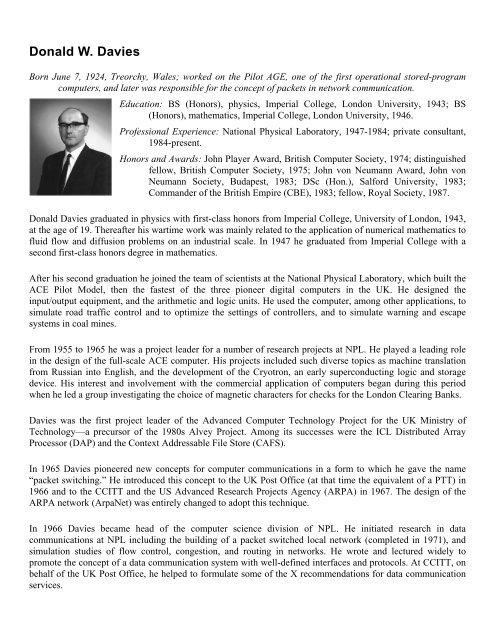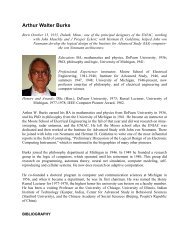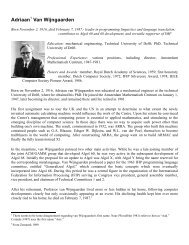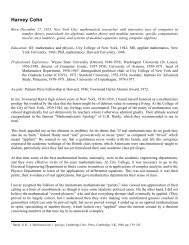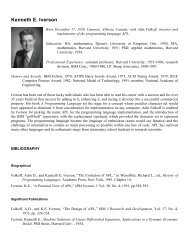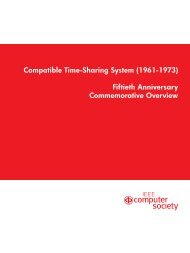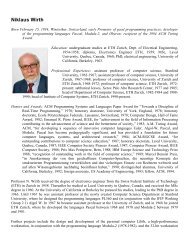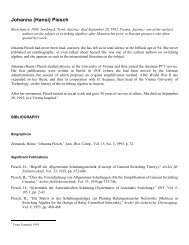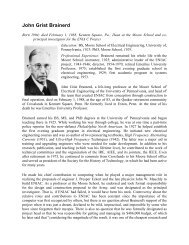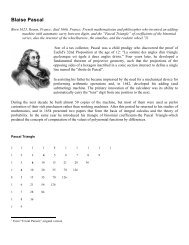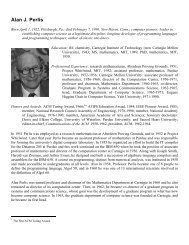Donald W. Davies - Walden Family
Donald W. Davies - Walden Family
Donald W. Davies - Walden Family
You also want an ePaper? Increase the reach of your titles
YUMPU automatically turns print PDFs into web optimized ePapers that Google loves.
<strong>Donald</strong> W. <strong>Davies</strong><br />
Born June 7, 1924, Treorchy, Wales; worked on the Pilot AGE, one of the first operational stored-program<br />
computers, and later was responsible for the concept of packets in network communication.<br />
Education: BS (Honors), physics, Imperial College, London University, 1943; BS<br />
(Honors), mathematics, Imperial College, London University, 1946.<br />
Professional Experience: National Physical Laboratory, 1947-1984; private consultant,<br />
1984-present.<br />
Honors and Awards: John Player Award, British Computer Society, 1974; distinguished<br />
fellow, British Computer Society, 1975; John von Neumann Award, John von<br />
Neumann Society, Budapest, 1983; DSc (Hon.), Salford University, 1983;<br />
Commander of the British Empire (CBE), 1983; fellow, Royal Society, 1987.<br />
<strong>Donald</strong> <strong>Davies</strong> graduated in physics with first-class honors from Imperial College, University of London, 1943,<br />
at the age of 19. Thereafter his wartime work was mainly related to the application of numerical mathematics to<br />
fluid flow and diffusion problems on an industrial scale. In 1947 he graduated from Imperial College with a<br />
second first-class honors degree in mathematics.<br />
After his second graduation he joined the team of scientists at the National Physical Laboratory, which built the<br />
ACE Pilot Model, then the fastest of the three pioneer digital computers in the UK. He designed the<br />
input/output equipment, and the arithmetic and logic units. He used the computer, among other applications, to<br />
simulate road traffic control and to optimize the settings of controllers, and to simulate warning and escape<br />
systems in coal mines.<br />
From 1955 to 1965 he was a project leader for a number of research projects at NPL. He played a leading role<br />
in the design of the full-scale ACE computer. His projects included such diverse topics as machine translation<br />
from Russian into English, and the development of the Cryotron, an early superconducting logic and storage<br />
device. His interest and involvement with the commercial application of computers began during this period<br />
when he led a group investigating the choice of magnetic characters for checks for the London Clearing Banks.<br />
<strong>Davies</strong> was the first project leader of the Advanced Computer Technology Project for the UK Ministry of<br />
Technology—a precursor of the 1980s Alvey Project. Among its successes were the ICL Distributed Array<br />
Processor (DAP) and the Context Addressable File Store (CAFS).<br />
In 1965 <strong>Davies</strong> pioneered new concepts for computer communications in a form to which he gave the name<br />
“packet switching.” He introduced this concept to the UK Post Office (at that time the equivalent of a PTT) in<br />
1966 and to the CCITT and the US Advanced Research Projects Agency (ARPA) in 1967. The design of the<br />
ARPA network (ArpaNet) was entirely changed to adopt this technique.<br />
In 1966 <strong>Davies</strong> became head of the computer science division of NPL. He initiated research in data<br />
communications at NPL including the building of a packet switched local network (completed in 1971), and<br />
simulation studies of flow control, congestion, and routing in networks. He wrote and lectured widely to<br />
promote the concept of a data communication system with well-defined interfaces and protocols. At CCITT, on<br />
behalf of the UK Post Office, he helped to formulate some of the X recommendations for data communication<br />
services.
Other research of the computer science division at this time was in pattern and speech recognition, CAD in<br />
architecture, human factors, and office systems that used the local network.<br />
In 1978 he was given an “individual merit” post as deputy chief scientific officer, allowing him to lead a<br />
research group without the management tasks of a division. He chose as his specialty the security of data in<br />
networks. The group developed the application of cryptographic methods to the practical needs of network<br />
security, especially the use of asymmetric (public key) cryptography. Consulting work under contract to<br />
financial institutions and others provided the practical experience.<br />
Since leaving NPL in 1984, <strong>Davies</strong> has provided consultancy to financial institutions on high value payment<br />
systems (SWIFT and CHAPS), ATMs, and EFT/POS. He has advised suppliers and users of secure systems of<br />
many kinds, including mobile telephone and direct broadcast satellites.<br />
BIBLIOGRAPHY<br />
Biographical<br />
Campbell-Kelly, Martin, “Data Communications at the National Physical Laboratory (1965-1975),” Ann. Hist.<br />
Comp., Vol. 9, No. 3/4,1988, pp. 221-248.<br />
Significant Publications<br />
<strong>Davies</strong>, D. W., “A Theory of Chess and Noughts and Crosses,” 1 Penguin Science News, Vol. 16, 1950, pp. 40-<br />
64.<br />
<strong>Davies</strong>, D. W., “Sorting Data on an Electronic Computer,” Proc. Inst. Elect. Eng., Vol. 103, No. 1, 1956, pp.<br />
87-93.<br />
<strong>Davies</strong>, D. W., “Switching Functions of Three Variables,” Trans. Inst. Radio Eng., Vol. 6, No. 4,1957, pp. 265-<br />
275.<br />
<strong>Davies</strong>, D. W., “A Communication Network for Computers and Their Remote Peripheral Devices,” Proc. Post<br />
Office/Industry joint Symp. on Pulse Code Modulation Transmission and Switching Systems, Brighton,<br />
UK, 1967.<br />
<strong>Davies</strong>, D. W., and D. L. A. Barber, Communication Networks for Computers, John Wiley, London, 1973.<br />
<strong>Davies</strong>, D. W., K. A. Bartlett, R. A. Scantlebury, and P. T. Wilkinson, “A Digital Communication Network for<br />
Computers Giving Rapid Response at Remote Terminals,” Proc. ACM Symp. Operating System<br />
Principles, ACM, New York, 1967.<br />
<strong>Davies</strong>, D.W., and W.L. Price, Security for Computer Networks, John Wiley, Chichester, U& 1984.<br />
1 Known in the US as “Tic Tac Toe.”
UPDATES<br />
Portrait added (MRW, 2012).


